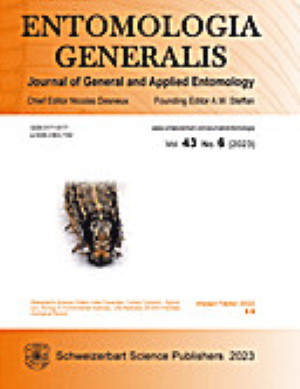氯氟吡氧乙酸对蚜虫生理和发育特征的亚致死效应和转代效应
IF 4.6
1区 农林科学
Q1 ENTOMOLOGY
引用次数: 0
摘要
秋虫(FAW,Spodoptera frugiperda J. E. Smith)是一种高度入侵性害虫,会给农作物产量造成重大损失。氯虫苯甲酰胺在中国已被广泛用于防治秋绵虫。本研究调查了虫螨腈对农田害虫的亚致死效应和转基因效应,以提高虫螨腈的合理利用率。经72小时接触,氯虫苯甲酰胺的LC10和LC20值分别为7.47和12.08 μg/g。低浓度的虫螨腈可延长幼虫期和卵化前期,降低 F0 代和 F1 代幼虫的体重、化蛹率和羽化率。此外,这种接触还降低了 F0 代的交配率、受精率和卵孵化率。与对照组相比,F0代3龄幼虫的摄食指标,包括相对生长率(RGR)、摄食食物转化效率(ECI)、消化食物转化效率(ECD)和相对消耗率(RCR)均显著下降,而近似消化率(AD)则有所提高。暴露于 LC10 或 LC20 的幼虫在 12 至 24 小时内表现出羧基酯酶(CarEs)、细胞色素 P-450s (P450s)和谷胱甘肽 S-转移酶(GSTs)活性升高。LC20 对 F1 代的长期生命表参数有不利影响,包括固有增长率(r)、有限增长率(λ)和净生殖率(R0)。这些研究结果表明,氯虫苯甲酰胺的亚致死效应会损害一窝蜂的生长和发育,影响 F1 代的种群动态。本文章由计算机程序翻译,如有差异,请以英文原文为准。
Sublethal and transgenerational effects of chlorfenapyr on physiological and developmental traits of Spodoptera frugiperda
The fall armyworm (FAW, Spodoptera frugiperda J. E. Smith), is a highly invasive pest causing significant crop yield losses. Chlorfenapyr has been widely utilized in China to control FAW. This study investigated the sublethal and transgenerational effects of chlorfenapyr on FAW to enhance its appropriate utilization. LC10 and LC20 values of chlorfenapyr were estimated to 7.47 and 12.08 μg/g after a 72-hour exposure, respectively. Low chlorfenapyr concentrations extended the duration of larval stage and pre-oviposition period, reducing larvae body weight, pupation rate and eclosion rate in both the F0 and F1 generations. Additionally, such exposure decreased the F0 generation’s mating rate, fecundity, and egg hatching rate. The feeding indicators in third instar larvae from the F0 generation, including relative growth rate (RGR), efficiency of conversion of ingested food (ECI), efficiency of conversion of digested food (ECD), and relative consumption rate (RCR), exhibited significant decrease compared to the control group, while approximate digestibility (AD) was higher. Larvae exposed to LC10 or LC20 exhibited elevated carboxylesterases (CarEs), cytochrome P-450s (P450s), and glutathione S-transferases (GSTs) activities from 12 to 24 hours’ exposure, Notably, GSTs activity was higher at 6-hours compared to the control group, while CarEs and P450s activities significantly decreased. LC20 adversely affected long-term life table parameters of the F1 generation, including intrinsic rate of increase (r), the finite rate of increase (λ), and the net reproductive rate (R0 ). These findings demonstrate that sublethal effects of chlorfenapyr can impair FAW growth and development, impacting the population dynamics of the F1 generation.
求助全文
通过发布文献求助,成功后即可免费获取论文全文。
去求助
来源期刊

Entomologia Generalis
生物-昆虫学
CiteScore
7.10
自引率
18.80%
发文量
72
审稿时长
>12 weeks
期刊介绍:
Its scope covers all aspects of basic and applied research dealing with insects and more broadly with arthropods inhabiting wild, agricultural and/or urban habitats. The journal also considers research integrating various disciplines and issues within the broad field of entomology and ecology.
Entomologia Generalis publishes high quality research articles on advances in knowledge on the ecology and biology of arthropods, as well as on their importance for key ecosystems services, e.g. as biological control and pollination. The journal devotes special attention to contributions providing significant advances (i) on the fundamental knowledge and on sustainable control strategies of arthropod pests (including of stored products) and vectors of diseases, (ii) on the biology and ecology of beneficial arthropods, (iii) on the spread and impact of invasive pests, and (iv) on potential side effects of pest management methods.
Entomologia Generalis welcomes review articles on significant developments in the field of entomology. These are usually invited by the editorial board, but proposals may be sent to the Editor-in-Chief for preliminary assessment by the editorial board before formal submission to the journal. The journal also considers comments on papers published in Entomologia Generalis, as well as short notes on topics that are of broader interest.
 求助内容:
求助内容: 应助结果提醒方式:
应助结果提醒方式:


